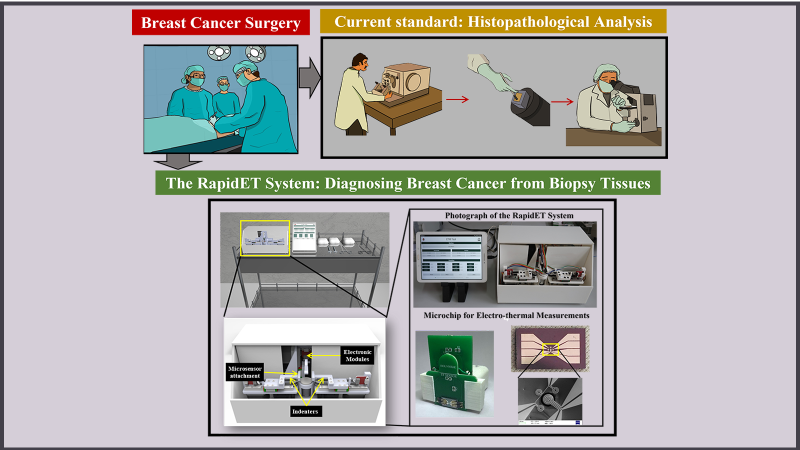
Image courtesy of authors
Breast cancer is the second largest cause of mortality in women globally. Therefore, rapid analysis of cancer biopsy tissue samples and periodic screening to detect cancerous growths are vital to saving the life of the patients. In addition, if a surgeon has access to a tool that can see the tumour-healthy tissue boundary after a tumour is removed, it will help them immensely to perform clean surgeries and reduce tumour regrowths. Currently, diagnostic results from tissue biopsies take 24-72 hours. They require skilled pathologists to assess the sample and ascertain if the sampled tissue still contains cancerous cells. Currently, surgeons use MRI and biopsy results to analyse how cleanly the tumour is removed.
Researchers from the Indian Institute of Science (IISc), Bengaluru, led by Prof. Hardik J. Pandya (Department of Electronic Systems Engineering) and Prof. Annapoorni Rangarajan (Department of Molecular Reproduction, Development, and Genetics) in collaboration with Assam Medical College, have developed a novel method of rapid diagnosis of breast cancer in biopsy samples. They have designed a microchip-based technology called the RapidET system, which can analyse biopsy samples in less than 15 minutes. The compact device provides valuable assistance to surgeons and requires a semi-skilled person to operate it. The study details are published in Microsystems and Nanoengineering, and the design patent is pending.
Cancer tissue analysis is a skill-based, labour-intensive process involving multiple steps and chemical reagents. First, the tissue sample is preserved in formalin, embedded in paraffin and then sliced for analysis. Then, a skilled pathologist carefully scrutinises the sample for levels of specific biomarkers such as estrogen receptor, progesterone receptor and human epidermal growth factor receptor 2, which indicate the degree of cancerous cells in the tissue.
Scanning electron microscopy is used to see the structure of breast tissues. Existing literature has shown that cancer tissues are generally more rough and coarse as opposed to a smoother structure of the normal tissue. This change in the cancer tissue structure is due to the modification of the tissue fibre content, which degrades the structure. The modified properties of the fibre also lead to the higher electrical resistance property in cancer tissue compared to the healthy tissue. Leveraging this concept, the team wanted to measure the electrical property of cancerous tissue and see if they could develop a technology that would minimise the analysis time of biopsy samples.
“As the resistance of healthy tissue and cancer tissue is different, the thermal conductivity of the tissue also will be different, “ says Dr Hardik Pandya, principal author of the study.
So the team ventured to ask several questions: how the electrical and thermal properties of breast cancer tissues are different from the nearby normal tissues; how these properties change when the tissues are heated from room temperature to body temperature; and whether such dynamic changes in the physical properties of the tissue can be used as a marker to diagnose breast cancer faster.
The team wanted to design an instrument to measure these values. Another critical aspect that this device could address was cancer -normal tissue margin at the surgical site. That is, how cleanly the tumour was removed and the surrounding tissue was free of cancerous cells.
The RapidET (Rapid Electro-Thermal analysis) system comprises two robotic arms fitted with silicon microchips. The microchips are integrated onto the platform using a slide-and-fit contact enabling quick replacement for different sample measurements. Each chip has heaters, thermistors, and electrodes to measure the electrical property of the tissue.
On-board electronic modules and mechatronic subsystems apply potential and heat across the biopsy sample. The microchips integrate readings from several sensors capable of measuring the electrical and thermal properties of the tissue and its temperature-dependent variations. For example, when the tissue is placed in the RapidET system and heat is applied to one arm, the tissue will conduct the heat to the other arm of the device. The electronics detect the changes in temperature, current, resistivity (surface resistivity and bulk resistivity) and other related parameters. Then the device gives a simple high - low readout by integrating the values from the different measurements.
Using the RapidET system, the team also wanted to see how the thermal conductivity of cancerous tissue was different from that of normal tissue. Dr Pandya says, “Our study also observes that using the changes in electrical resistivity with temperature and combining it with thermal conductivity measurements gives a metric to classify tissue as a tumour or normal. This is a novel strategy that can reduce the analysis time for each sample to 14 ± 2 mins.”
The team performed thermal conductivity experiments with 40 normal and cancerous tissue samples. They found that for temperature variations from room temperature (25 C) to human body temperature (35 C), the cancerous tissue exhibited a larger electrical resistivity and lower thermal conductivity than normal tissue. In the next stage, the team proposes to analyse 200 samples and test samples from all over India to factor in regional variations of cancer-causing biomarkers.
The researchers are now scaling up the device with an additional robotic arm that will measure the stiffness of the tissue sample. With an added parameter, they could glean further insights into the progression of the disease. Dr Pandya says, “Down the line, we intend to develop a pen-type instrument for surgeons to easily ascertain the tumour-healthy tissue margin in situ (during surgery).”
This article has been run past the researchers, whose work is covered, to ensure accuracy.






